IBM is integrating AI at Wimbledon for better fan engagement and athlete training. How is AI being utilised in the sports industry, particularly in tennis?
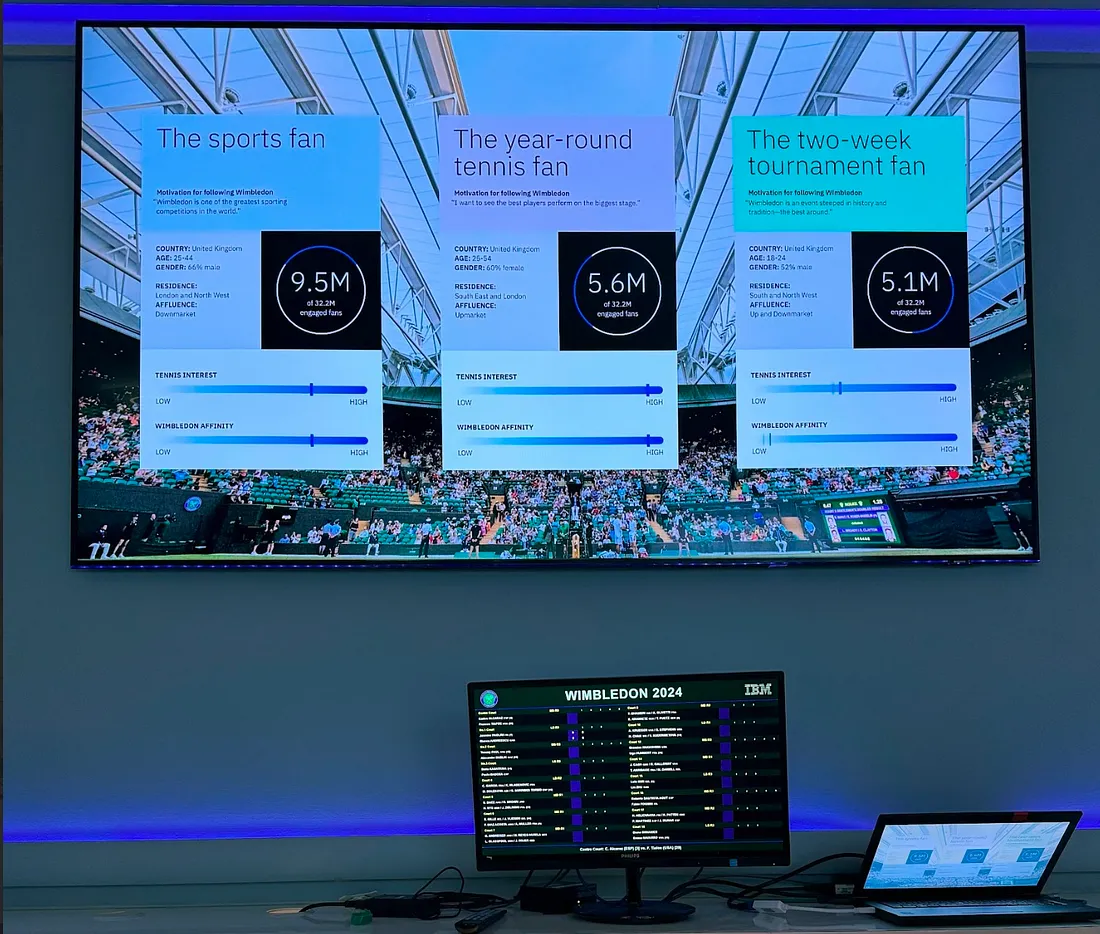
The digital transformation innovations and explosions in data analytics, and Artificial Intelligence, are shifting the sports in general and benefiting sports professionals, organisations and sports fans around the world.
Artificial Intelligence (AI) is increasingly being integrated into sports, with tennis serving as a notable example of its significant impact.
Globally, billions of people are passionate about sports, and tennis ranks as the fourth most popular sport, with an audience of 1.2 billion people, according to industry benchmarks.
Research is showing us how to use these innovative technologies and AI to accelerate better ways to play and watch the sports we love. Special Tennis. AI and related technologies are being adopted across various dimensions of sports, becoming powerful tools for practitioners, sports personalities, fans, and sports organisations.
Before we move on, here are some important key metrics and critical elements of the Sport of Tennis:
- Tennis Professional Global Tours:
- ATP (Association of Tennis Professionals) for men
- WTA (Women’s Tennis Association) for women
- ITF (International Tennis Federation) oversees major international team events
- Major Tennis Tournaments:
- Four Grand Slams: Australian Open, French Open, Wimbledon, and US Open
- ATP/WTA Tour events
- Davis Cup and Billie Jean King Cup (formerly Fed Cup) for national teams
- Tennis Grassroots Development:
- Focus on junior programs and local clubs to nurture talent and make tennis more accessible in underserved communities
- Tennis Technology and Innovation:
- One of the most innovative sports that has advanced Integration of technologies, AI and data analytics in training and match strategy
- Tennis Media and Broadcasting:
- Extensive TV coverage of major events and growing digital presence through streaming platforms and social media
- Tennis Economic Impact:
- Significant contributor to sports tourism
- Large market for tennis equipment and apparel
- Sponsorship and endorsement deals for top players
- Tennis Health and Fitness:
- Promoted as a lifelong sport for physical fitness and mental well-being
- Growing popularity of recreational tennis among older adults
- Tennis Sustainability:
- Tennis sports organisations and players are increasing their focus on environmental sustainability in tournament operations
- Efforts to reduce carbon footprint and promote eco-friendly practices
 The applications of AI in Sports and Tennis
The applications of AI in Sports and Tennis
Being one of the most innovative sports, tennis is increasingly using advanced technology and AI.
How is AI being utilised in the sports industry, particularly in tennis? Here are some examples of innovation and technology deployments in tennis:
Performance Analysis and Training Wearable Devices: Athletes use wearable devices that track various metrics such as heart rate, speed, stroke counts, physiological data and movement patterns. AI algorithms analyse this data to provide insights into an athlete’s performance and areas for improvement.
Motion Capture Systems: AI-powered motion capture systems analyse athlete’s biomechanics, aiding coaches with correct techniques, and most importantly, injury prevention.
Game Strategy and Tactics Predictive Analytics: AI models predict opponents’ strategies and tendencies by analysing historical data, allowing teams to devise effective counter-strategies.
Video Analysis: AI software breaks down game footage to identify patterns and provide strategic insights about understanding opponents’ weaknesses and improving team tactics. IBM’s AI and data platform, watsonx, is used for real-time and post-match analysis, providing data and insights during the match, further enhancing the efficiency of the decision-making process.
Fan Engagement and Experience Personalised Content: AI tailors content for fans based on their preferences, such as customised highlight reels or interactive experiences during live games. Chatbots and Virtual Assistants: AI-powered chatbots provide fans with real-time information, answer queries, and enhance overall engagement.
Injury Prevention and Management Predictive Models: AI predicts potential injuries by analysing patterns in an athlete’s physical data and workload, allowing for preemptive action.
Rehabilitation: AI assists in designing personalised rehabilitation programs by tracking progress and adjusting exercises as needed.
Recruitment and Scouting Talent Identification: AI analyses data from various sources, such as amateur games and social media to identify promising talent that might otherwise be overlooked by traditional scouting methods.
The impact of AI in tennis is still in its infancy, yet its first stages are already showing promising signs of revolutionising the way the tennis sector works:
Stats, player movements, and even the ball’s trajectory could be superimposed onto the live video, providing a unique and immersive viewing experience. AI may soon be able to predict player strategies based on historical data and current performance, making the sport even more challenging and exciting.
One of the cutting edge critical technologies case studies is the Hawkeye system. Invented by a young British computer expert Paul Hawkins, and launched in 2001, it was first used in television coverage of sporting events such as Test cricket, and has now reached the stage of being used by officials in tennis to assist in adjudicating close line calls. In the case of Tennis and Wimbledon The Hawk-Eye system uses between six and ten cameras positioned at multiple angles around the court to create a three-dimensional representation of the ball’s trajectory. This is presented on a screen to players, spectators and officials, as well as television viewers.
AI in Sports: The Game Enabler
We’ve already seen glimpses of AI impacting 360 sports and becoming more integrated within live matches and sports commentating, better informing audiences and aspiring players who seek to learn from the professionals. Tennis is a game of intelligence, and while it is still developing, AI is making the game smarter, more sustainable and competitive.
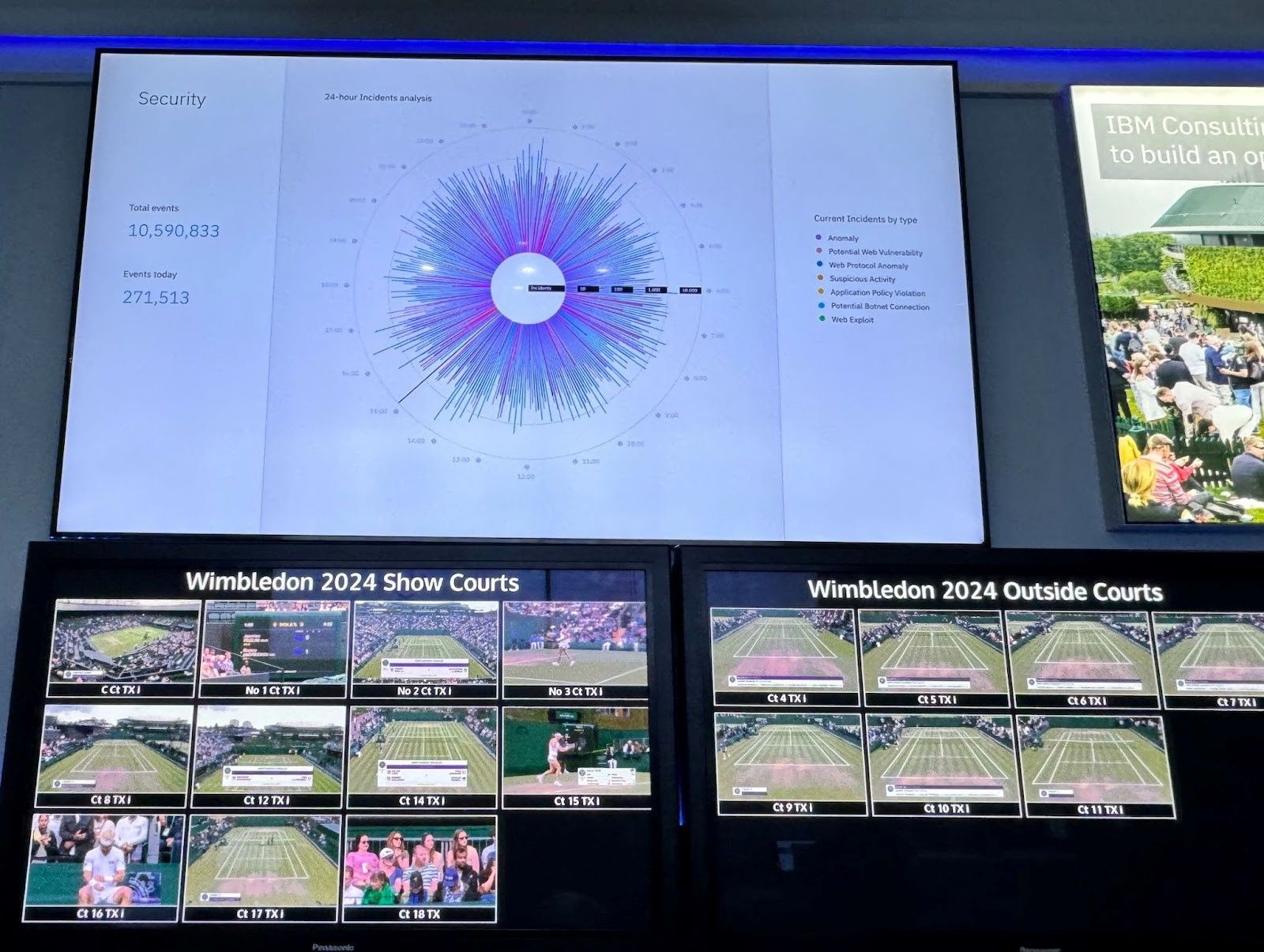
These are the tennis sports areas that will be increasingly influenced by AI driven innovation and tools:
Virtual Training Tools: One of the most exciting and potentially most beneficial is Sense Arena, which uses virtual reality to allow players to simulate real tennis scenarios off the court.
Match Analysis and Coaching Real-Time Analytics: During matches, AI systems provide real-time statistics and analytics on player performance, shot placement, and rally patterns, aiding coaches and players in making strategic decisions.
Post-Match Analysis: Detailed post-match reports generated by AI highlight strengths and weaknesses, helping players to refine their game.
Player Performance and Training Stroke Analysis: AI tracks and analyses the mechanics of a player’s strokes, offering insights to improve technique and efficiency.
Fitness Monitoring: Wearable technology and AI monitor physical fitness parameters, ensuring players are in optimal condition and preventing overtraining.
Match Prediction and Strategy Predictive Analytics: AI models predict the outcome of matches based on player statistics, historical performance, and playing conditions. This helps develop efficient match strategies and better prepare for opponents.
Fan Interaction and Broadcast Enhancement Augmented Reality (AR) and Virtual Reality (VR): AI plays a pivotal role in enhancing broadcast experiences with AR and VR, providing fans with immersive and interactive viewing experiences.
Personalised Viewing: AI curates personalised highlights and matches content for fans based on their interests and viewing history.
Umpiring and Officiating Hawk-Eye Technology: AI-powered Hawk-Eye technology is used to make line calls and review disputed points, significantly improving the accuracy of officiating in tennis matches.
Automated Refereeing: AI systems assist referees in making real-time decisions, reducing human error and ensuring fair play. This, in turn, instils a sense of reassurance and confidence in the fairness of the game.
Player Development and Scouting Junior Talent Identification: AI analyses junior players’ performance data to identify potential future stars, assisting in early talent identification and development.
Performance Trajectories: AI models predict the future performance trajectories of young players, helping coaches and scouts make informed decisions about player development.
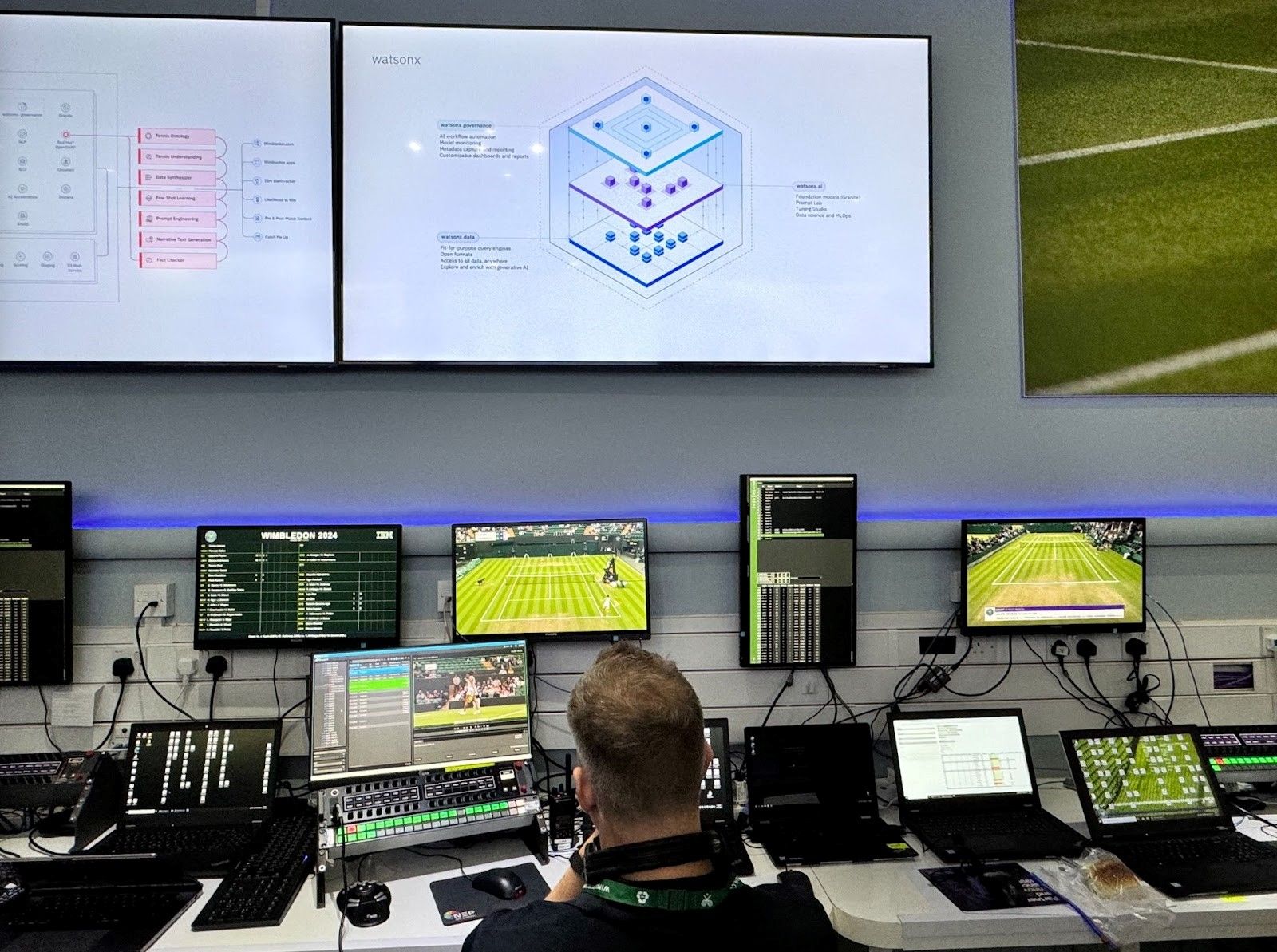
How IBM is integrating AI in tennis: A Wimbledon Case Study
IBM, a trusted technological partner for Wimbledon, the biggest tennis competition worldwide, has been enhancing both the fan and player experiences for over three decades. This enduring partnership has been instrumental in the use of advanced AI and cloud technologies.
Here are some key aspects of their collaboration:
Data Analytics and Insights: IBM data collections and analysis during the tournament is on a massive scale. Since 1990, IBM has collected over 62 million data points, providing real-time match statistics and player insights. The IBM Slamtracker, offers live analytical insights by processing historical and real-time match data, enriching the understanding of match dynamics and player performance for fans and analysts (IBM, 2023).
AI and Cloud Technologies: IBM uses a hybrid cloud model to handle the enormous data flow and digital traffic during Wimbledon. This setup includes on-premise video encoding and scoring system, private clouds for secure data management, and public clouds for scalability. The infrastructure can scale up by 55,000% during the tournament to meet the high demand (IBM, 2023).
Match insights by the IBM Power Index and AI-powered draw analysis predict player performance and match outcomes. These insights are accessible through the Wimbledon app and website, enhancing the digital experience for fans worldwide (IBM Newsroom, 2023).
Fan Engagement: IBM has developed in past years several tools to enhance fan engagement. An example was the AI-powered “Have Your Say” feature that allowed fans to predict match outcomes and compare their predictions with those of IBM’s AI. Personalised Recommendations and Highlights Reels inform fans about players they follow, leveraging AI to provide tailored content (IBM Newsroom, 2023).
Innovations like AI commentary, which uses IBM watsonx to generate natural language commentary for match highlights, and AI-based player emotion recognition, helps create engaging highlight reels to further enrich the viewing experience (IBM, 2023).
Technological Innovation: IBM continually introduces new technologies to improve the Wimbledon digital experience. Recent advancements include using IBM watsonx, an enterprise-grade AI and data platform, to develop features like AI Commentary for highlights videos and AI Draw Analysis. These tools enhance the fan experience and also provide deeper insights into match statistics and player performance (IBM, 2023).
Wimbledon Championship: History, Evolution with AI innovations from IBM, and impact in the last 30 years
The Wimbledon Championships is the oldest tennis tournament in the world, held for the first time in 1877 at the All England Lawn Tennis and Croquet Club in Wimbledon, London. The Championship has undergone significant transformations in the past three decades, largely due to technological advancements and partnerships with companies like IBM.
The IBM Wimbledon partnership began in 1990, marking the beginning of a new data and analytics driven sports era in the history of tennis. This collaboration has revolutionised how the tournament is experienced by fans, providing them with a deeper understanding of the game and a more engaging experience.
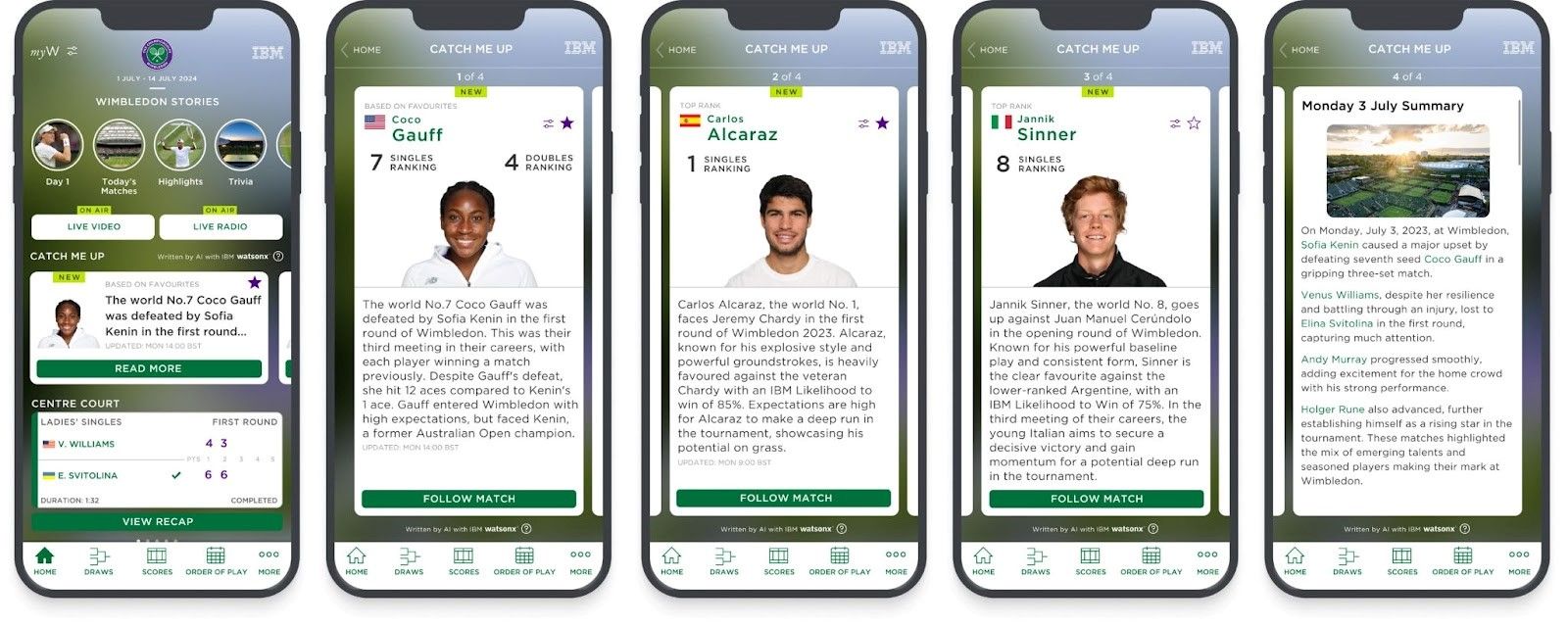
Key milestones include:
1990: IBM begins providing statistical support to Wimbledon.
2001: IBM introduces the Hawkeye system, enhancing the accuracy of line calls.
2009: The Wimbledon iPhone app is launched, bringing real-time updates to mobile devices.
2015: IBM Slamtracker introduced to provide predictive analytics for matches.
2019: AI-powered highlights creation, automatically generating video content based on crowd reactions and player emotions.
2023: AI commentary for match highlights videos and IBM AI Draw Analysis implemented.
The impact of these innovations has been profound. Wimbledon has maintained its status as the premier tennis event while embracing cutting-edge technology. Today, the tournament reaches a global audience of over 1 billion people across 200 territories (Wimbledon, 2023).
The partnership with IBM has not only enhanced the fan experience but also provided players and coaches with invaluable data and insights. This has contributed to the evolution of playing styles and training methods in professional tennis.
Wimbledon’s technological advancements have set a benchmark for other sporting events, influencing how data and AI are used across the sports industry.
Through this strong tech and digital partnership, IBM has helped Wimbledon maintain its status as a premier global sporting event, blending tradition with cutting-edge technology to provide a seamless and immersive experience for players, fans, and media alike.
IBM also has a relationship with tennis that goes beyond Wimbledon. These are some of the areas that are important to mention as well:
In-Game & Post-Match Statistics, Analysis and Predictive AI: IBM’s AI and watsonx capabilities are connecting fans and journalists to the game in deeper and more intimate ways than ever before. The two new interactive AI-enabled innovations are Open Questions With Watson and Match Insights With Watson Discovery.
Open Questions with Watson employs Natural Language Processing (NLP) capabilities in IBM’s Watson Discovery, IBM Project Debater, and custom AI algorithms to generate and moderate a public conversation during the tournament over questions like “Is Serena Williams the best player in tennis?” and “Does Pete Sampras have the best all-around tennis game?”
Match Insights with Watson provides fans with a “tip sheet” for each match. It uses Watson Discovery NLP technology and custom Natural Language Generation algorithms to analyse millions of written articles from news, sports journalism, and other sources to glean the most relevant facts and insights and write short, data-rich articles to preview each match-up.
The technology is smart enough to monitor up to 18 individual matches simultaneously. It can also rank the most entertaining points from every match by analysing player reactions and listening to the crowd’s reactions.
Player Digital Outreach and Protection: With more athletes raising concerns about mental health in sports, tournaments are taking steps to support players in their virtual worlds as well as on the court. At Roland Garros (French Open), the tournament introduced AI-driven software by BodyGuard.ai. Players can integrate this technology with their social media accounts to filter out abusive comments and block harmful remarks.
Equipment Maintenance and Evolution: Leading racquet manufacturer Babolat, has introduced racquets with built-in sensors that can connect to a player’s phone to provide dynamic feedback on performance. This IoT and AI enabled evolution in equipment are prime examples of how technology is leveraging the sports industry with innovative solutions.
Another example is the use of “smart” dampeners like Qlipp, which collects data on a player’s strokes, speed, accuracy, and sweet spot vibrations, providing recreational players access to valuable stats and data points.
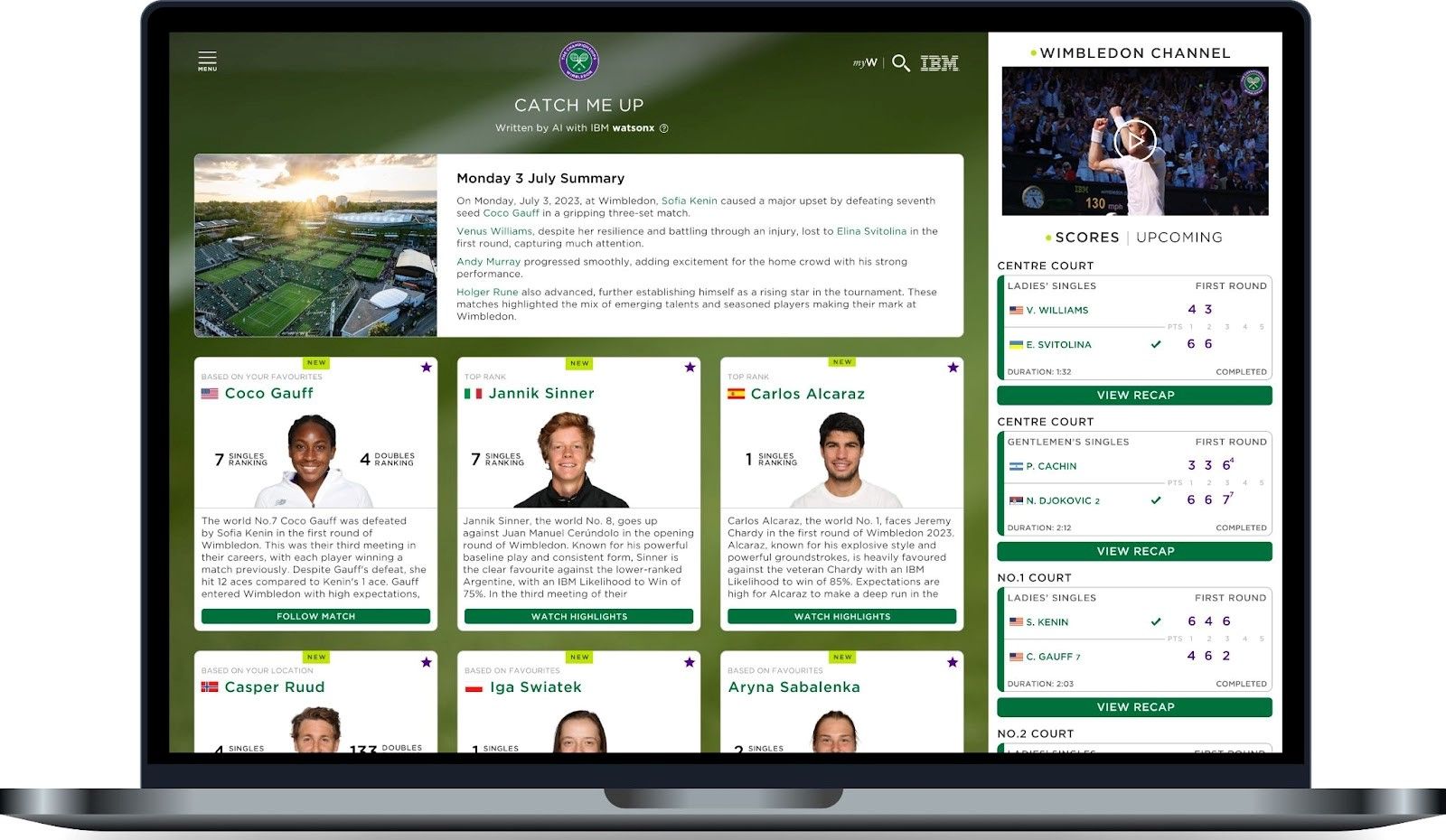
‘Catch Me Up’ Gen AI tennis summaries: Wimbledon and IBM’s new digital experience
In 2024, Wimbledon and IBM introduced a groundbreaking feature called ‘Catch Me Up’, leveraging generative AI to enhance the fan experience. This innovative tool provides personalised summaries of tennis matches, allowing fans to quickly catch up on the action they’ve missed (BusinessABC, 2024).
Key features of ‘Catch Me Up’ include:
- Personalised Summaries: The AI generates concise, tailored summaries of matches based on the user’s interests and the available time to catch up.
- Multi-Modal Content: The summaries in ‘Catch Me Up’ are more than just brief, they are comprehensive. They incorporate various types of content, including text, images, and statistics, providing a thorough comprehensive overview of the match.
- Near Real-Time Updates: ‘Catch Me Up’ feature allows systems to continuously update themselves with the latest information and match progress, ensuring an uninterrupted fan engagement.
- Integration with Existing Platforms: ‘Catch Me Up’ is seamlessly integrated into the Wimbledon app and website, enhancing the overall digital experience.
- Customisation Options: Users can specify their preferences, such as favourite players or particular types of match information they’re most interested in.
With this new feature, IBM demonstrates how AI can be used to make complex sporting events more accessible and engaging for fans, particularly those who may not have the time to watch entire matches. This is nothing short of a significant leap into an era of personalised sports content delivery and a perfect showcase of the potential of AI in enhancing fan engagement across various sports.
AI in Sports and Tennis – The Beginning of a Journey
Innovative AI tools are increasingly transforming sports, and tennis is a prime example of this impact. As discussed earlier, tennis, a sport enjoyed by 1.2 billion people, and tournaments like Wimbledon, generates millions of data points per match. These data points can be leveraged to enhance the game at all levels.
AI’s integration into sports, especially tennis, is revolutionising the way people practise sports and especially tennis in athlete performance, training, competition, and fan engagement. From performance analysis, coaching, to injury prevention and fan interaction, AI provides valuable tools that improve various aspects of the sports industry. As technology advances, its impact on sports will likely expand, offering even more sophisticated and nuanced applications.
The introduction of Generative AI features like ‘Catch Me Up’ at Wimbledon demonstrates how AI can make tennis more accessible, more dynamic and engaging for fans worldwide. By providing personalised, real-time summaries, AI is helping to bridge the gap between professionals, casual viewers and die-hard fans, potentially attracting new audiences to the sport.
As AI continues to evolve, we can expect it to play a crucial role in transforming every aspect of tennis in unimaginable ways. From improving player performance and strategy to enhancing the viewing experience and making the sport more inclusive, sustainable, AI is set to redefine the future of tennis.
The partnership between IBM and Wimbledon is a case study role model of 30 years highlighting how technology can be integrated into traditional sports, preserving their essence while embracing innovation and performance. As we look to the future, it’s clear that AI will continue to be a driving force in the evolution of tennis and sports as a whole, creating new opportunities for players, fans, and organisations alike.
Additional Sources:
Artificial Intelligence in Sport Performance Analysis
By Duarte Araújo, Micael Couceiro, Ludovic Seifert, Hugo Sarmento, Keith Davids
Copyright 2021
Leveling Up With AI: A Strategic Guide to AI in Sports Marketing (Level Up) Kindle Edition
by Shripal Shah (Author), Feb 20, 2024
https://www.amazon.com/Leveling-Up-AI-Strategic-Marketing-ebook/dp/B0CW1LK3DG
Sports and Technology Have the Power to Change the World: Driving Positive Change Through the Use of Data and AI, 2024

Dinis Guarda is an author, academic, influencer, serial entrepreneur, and leader in 4IR, AI, Fintech, digital transformation, and Blockchain. Dinis has created various companies such as Ztudium tech platform; founder of global digital platform directory openbusinesscouncil.org; digital transformation platform to empower, guide and index cities citiesabc.com and fashion technology platform fashionabc.org. He is also the publisher of intelligenthq.com, hedgethink.com and tradersdna.com. He has been working with the likes of UN / UNITAR, UNESCO, European Space Agency, Davos WEF, Philips, Saxo Bank, Mastercard, Barclays, and governments all over the world.
With over two decades of experience in international business, C-level positions, and digital transformation, Dinis has worked with new tech, cryptocurrencies, driven ICOs, regulation, compliance, and legal international processes, and has created a bank, and been involved in the inception of some of the top 100 digital currencies.
He creates and helps build ventures focused on global growth, 360 digital strategies, sustainable innovation, Blockchain, Fintech, AI and new emerging business models such as ICOs / tokenomics.
Dinis is the founder/CEO of ztudium that manages blocksdna / lifesdna. These products and platforms offer multiple AI P2P, fintech, blockchain, search engine and PaaS solutions in consumer wellness healthcare and life style with a global team of experts and universities.
He is the founder of coinsdna a new swiss regulated, Swiss based, institutional grade token and cryptocurrencies blockchain exchange. He is founder of DragonBloc a blockchain, AI, Fintech fund and co-founder of Freedomee project.
Dinis is the author of various books. He has published different books such “4IR AI Blockchain Fintech IoT Reinventing a Nation”, “How Businesses and Governments can Prosper with Fintech, Blockchain and AI?”, also the bigger case study and book (400 pages) “Blockchain, AI and Crypto Economics – The Next Tsunami?” last the “Tokenomics and ICOs – How to be good at the new digital world of finance / Crypto” was launched in 2018.
Some of the companies Dinis created or has been involved have reached over 1 USD billions in valuation. Dinis has advised and was responsible for some top financial organisations, 100 cryptocurrencies worldwide and Fortune 500 companies.
Dinis is involved as a strategist, board member and advisor with the payments, lifestyle, blockchain reward community app Glance technologies, for whom he built the blockchain messaging / payment / loyalty software Blockimpact, the seminal Hyperloop Transportations project, Kora, and blockchain cybersecurity Privus.
He is listed in various global fintech, blockchain, AI, social media industry top lists as an influencer in position top 10/20 within 100 rankings: such as Top People In Blockchain | Cointelegraph https://top.cointelegraph.com/ and https://cryptoweekly.co/100/ .
Between 2014 and 2015 he was involved in creating a fabbanking.com a digital bank between Asia and Africa as Chief Commercial Officer and Marketing Officer responsible for all legal, tech and business development. Between 2009 and 2010 he was the founder of one of the world first fintech, social trading platforms tradingfloor.com for Saxo Bank.
He is a shareholder of the fintech social money transfer app Moneymailme and math edutech gamification children’s app Gozoa.
He has been a lecturer at Copenhagen Business School, Groupe INSEEC/Monaco University and other leading world universities.


 The applications of AI in Sports and Tennis
The applications of AI in Sports and Tennis









